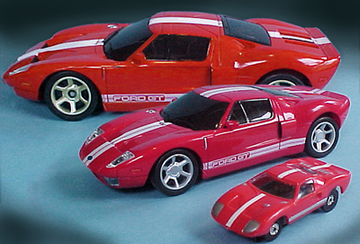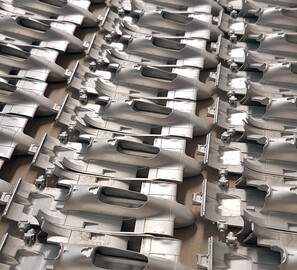John Day Models
Brand
It is thanks to an in-depth interview with John Day by Motor Sport magazine in October 1995, that we can understand how John became involved in both model cars and sponsorship of the Grand Prix world. It was Christmas 1957 when as a result of a cancelled cocktail party, and the need to clear away all his son’s toys, that he amused himself considering how to improve the authenticity of a Dinky Toys Cunningham racing car. He filed away, and repainted it, until for him it looked like a Cunningham.
John began swapping Solido models with a French journalist friend, and modified them to improve their authenticity. This was just a hobby, but when in 1969 he was able to set up in business himself, as a result of his employer being taken over, he decided to make 1:43 cars in kit form. After experimenting with the modifications for his existing centrifugal casting processes, in April 1970 he was ready to launch his first two models. These were a 1914 Mercedes, and the 1954 Ferrari Le Mans winner.
Subject ID: 2775
MoreIt is thanks to an in-depth interview with John Day by Motor Sport magazine in October 1995, that we can understand how John became involved in both model cars and sponsorship of the Grand Prix world. It was Christmas 1957 when as a result of a cancelled cocktail party, and the need to clear away all his son’s toys, that he amused himself considering how to improve the authenticity of a Dinky Toys Cunningham racing car. He filed away, and repainted it, until for him it looked like a Cunningham.
John began swapping Solido models with a French journalist friend, and modified them to improve their authenticity. This was just a hobby, but when in 1969 he was able to set up in business himself, as a result of his employer being taken over, he decided to make 1:43 cars in kit form. After experimenting with the modifications for his existing centrifugal casting processes, in April 1970 he was ready to launch his first two models. These were a 1914 Mercedes, and the 1954 Ferrari Le Mans winner.
His journalist friend Christian Moity covered this event with 2 colour pages in L’Automobile magazine. John recounted burning the midnight oil making the kits ready for taking by aeroplane to Le Mans for the 1970 race.
For the following 4 years John found himself running a successful new venture. In 1974 he was asked by Alain de Cadenet if he would sponsor his Lola in the Le Mans race. Two years later, and now employing 26 people, his company moved further into sponsorship by funding the Ensign team to run Chris Amon. Regrettably this deal didn’t work out. However, on a trip to the USA in 1976, he reached agreement with Max Mosley to sponsor the March team. This resulted in “John Day Model Cars” being displayed in large letters on the nose cone of Hans Stuck’s March. Sponsorship in the 1970s was still in its infancy, yet John recalled that his relationship with Mosley and March was always very congenial.
John had always felt that sponsorship in motor sport had not adversely affected the sport, rather the bright colours had brought the cars alive, and provided a means of financing a very expensive game. His heroes were Hans Stuck, Ronnie Peterson and Jackie Stewart.
In order to re-create the spirit of the racing cars he modelled, John believed more emphasis should be placed on photographs than engineering drawings. He proudly told Motor Sport of the day his son Crispin presented Graham Hill with a set of Lotus 49s, with which Graham was truly pleased.
In June 1976 Ray Ashworth, a regular builder of John Day kits, had hopes of building his own model from patterns, and knew a Ferrari 330LMB in France which fitted the bill. He asked John for advice, and was invited to John’s workshops in Pickerslea Road, Malvern. Ray was impressed with the comprehensive set-up of library, office, canteen workshop and casting facilities. This was not a cottage industry. He became aware that John was casting for other producers, such as Mikansue. Ray was engaged to build models for the Ferrari museum and the Laguna Seca Raceway owner. After completing the first batch at a rate of 2-3 models per week, Ray was again invited to the works, and a proposal made for Ray to be the front man for a new range called Le Mans Replicas. John already had other ranges including Mini Auto, and Equipe. A company was established, with John’s wife, his manager Alan and Ray as directors. John wanted Ray to run this line from his home to keep overheads down and maximise profit. It was to be mail order, cutting out the retail trade.
Ray produced the masters from both fibre material and brass, but along the way there was a dispute with the French maker, and former Le Mans shop owner Manou in Le Mans over the name, which was subsequently changed to V de C – Vainqueurs de Course. The formula was simple castings, reasonable quality, and a wide range of models. However, as other makers improved their quality, Ray tried in vain to persuade John to respond. John then decided to invest in equipment to produce a diecast F1 March. Thousands were sold, via retail outlets such as Beatties, but this project was also about expansion and volume sales.
During this time, John had been enjoying the buzz of success and the Grand Prix circus, but in 1980 John Day Model Cars crashed, with debts that couldn’t be paid. Overstretched plans and budgets, pattern makers not paid for their work, and collectors submitting payment for kits that did not arrive, these were some of the issues that then became more widely known. He recognised that he had expanded the business too quickly, and felt personally responsible when his staff were out of a job. His pattern maker, Richard Stokes, had left a secure job at Purdy the gunmakers, but became self employed from then on. The Pickerslea Road factory was closed, and Ray moved on to work for John Simons of Marsh Models.
From that point, John left the world of model cars and turned to public relations. However, in the mid 1990s, he decided to return. He first experimented with pewter sculptures of famous motor racing scenes. However, he soon turned back to white metal, and 1:76 scale kits.
Known as the John Day Vehicle Scenics range they consisted of 1:76 white metal kits available by mail order from John Day or via an agent (Woodpecker) in Australia. He was also advertising the ability to supply made up kits from time to time, partly through meeting up with Steve Bates, who had originally made patterns for his earlier ranges. He re-appeared on the scene later on and focused on vehicles to accompany popular railway modelling eras in the UK. After John passed away in the summer of 2006, the models seemed to have disappeared from the market.
However, all was not lost. John’s son Crispin and partner Caroline endeavoured to carry on the John Day model business in an attempt to continue supplying this range of models. Equally important, Crispin realised it would be a sad loss for modellers around the world if the model range which was his fathers’ legacy were to slip away. Unfortunately as Crispin and Caroline were both professionals with young children and already lived very busy lives, they realised that to carry on with the models was too all consuming.
Daryle Toney, a time served engineer for the last 30 years had been a self employed antique furniture restorer. His passion for making models, like so many others, began as a child running up to the newsagents with his 1/6d pocket money on a Saturday morning to buy an Airfix kit. Daryle was finding it difficult to obtain sufficient work, and was dismantling the N gauge model railway that he had built up, with a view to its sale. He found that the white metal model vehicles sold particularly well, so he bought some more from eBay, built the kits and sold them as handbuilts to a high standard.
Many of these kits were the JDM series that Crispin Day was selling, and through this he got to know Crispin. They talked about how to progress the business, and Crispin realized that Daryle had a real passion for small scale white metal kits. As a result, in order to continue the range of models and his father’s name Crispin passed the business over to Daryle Toney in August 2009, knowing that Daryle would ensure John Day’s name and work would continue.
Daryle’s aspirations for the JDM range are firstly, to re-master wherever possible with improvements, notably the wheels, to enable collectors to paint them more easily. New masters in brass will be made and wheels will be available for kit builders to upgrade models. His vision now is that, with the power of the internet, he may be able to tempt at least some of the younger generation away from their computers and electronic games and re-kindle the art of model making. Daryle sees this as a pastime that will last a lifetime, otherwise these skills will be lost forever.
Daryle will be concentrating on the heavy commercials, railway vehicles, related items and machining of brass masters for the wheels. He is a pattern maker as well as a modeller, and is using the skills of Rod Parker to refurbish some of the cars, especially those he mastered in the first place, John Day used as many as five different pattern makers but Daryle considers Rod to be one of the finest.
Daryle feels that there is still a place for the small manufacturer, and whilst manufacturers such as Oxford Diecast and Classix are undoubtedly affecting the market, he intends to produce items they are not likely to, such as animals, figures and sundry items for the railway modeller. He produces kits for people who like to model and gain satisfaction in making something. He feels that with mass produced items, once these are removed from their packaging the magic evaporates. He says that Oxford Diecast and Classix are for those who would buy a print and hang it on the wall, whilst his customers would rather create that picture by completing a jig-saw puzzle and gaining much pleasure in doing so.
Subject ID: 2775
Subject ID: 2775

